Every business has been affected by the pandemic, but those that were willing to pivot had an easier go at it.
I'm the founder of Selly Automotive, so I'll use the automotive industry as an example. As the pandemic began, car dealerships scrambled to set up online pricing, catalogs, and digital showrooms. This trend started out with showroom-based minimal viable products (dealerships started out with simple "buy online" buttons), but it evolved into online appointments, better scheduling tools, and an industry-wide transition into more agile management practices.
Car dealerships and other traditional sales environments are still very much in the game thanks to their agility and fast adoption of new technology. Here, I'll walk through some of the strategies and tools they adopted, and how you can take a page out of their book when it comes to omnichannel technology.
How SMBs can leverage omnichannel technology
While sometimes a competitive advantage is gained by early adopters with good foresight, other times legacy industries are forced to change quickly or die off.
Showroom-based businesses in the early stages of the pandemic had to adapt to digital environments or go out of business. There was no in-between. Scheduling tools, virtual visits, online financing and documentation tools, and eCommerce platforms were all put into action in mere months—or even weeks in some cases.
With entrenched employees and company norms, these changes didn't come easy, but even the most resistant employees learned quickly out of necessity: without these new tools, sales were simply not made.
In some cases, this process happened organically. Lead acquisition required an online eCommerce presence, booking client visits required virtual appointment apps, and making sales required computer-based financial tools. Step by step, the process integrated itself.
eCommerce

2020 saw the adoption of online wholesale platforms by car dealers and wholesalers alike, a new model that replaces legacy systems and allows dealers to save money on floorplan financing, improve inventory flow, and create a leaner, more agile supply chain.
But perhaps the biggest revelation in eCommerce was the advent of virtual visits and the growth of video-chatting as a sales platform. Nowhere was this better executed than the bike industry. Priority Bicycles, a New York bike shop that was quick to adapt, uses this model for booking 25-minute online video conferences for sales appointments, bike fittings, and even repair questions. Unifying the physical storefront with an online platform allowed for a new type of relationship with the store as well as a new venue for customer interaction.
The bike industry as a whole experienced massive and unprecedented growth during the last year, but when you're willing to invest in new technologies, it's easy to compound on success.
Inventory management
Supply chains were another casualty of COVID-19. When factories halted production and borders closed down, demand in many industries exploded. Businesses within the auto industry without accurate inventory management had to figure things out quickly, or they would run into big problems. Early shortages showed that dealers wouldn't just compete for clients, but for the cars themselves, too.
Collaborating with upstream automakers, dealers who could get incoming vehicles listed on online platforms could start selling and advertising before the cars even arrived on the lot. Whether by using parent-company tools or building out their own systems, adapting to scarce supply chains allowed well-organized dealers to gain an advantage over competitors.
Many dealerships also adopted automotive CRM integrations specific to the industry, allowing them to easily distribute incoming inventory information to sales associates.
Marketing
It's obvious that people spent more time on screens in 2020, and the growth of online content is absolutely mind-boggling.
That's all fantastic news for omnichannel businesses and marketers. More time spent online and more users shopping online allows for more opportunities to grab clients' attention. While some industries were used to digital marketing, dealerships needed to adapt. And in many cases, family auto dealers are now skipping balloons and sign-spinning mascots to take a closer look at tactics with more granular data like SEO and PPC.
Employee management
While showroom-style businesses in the past have typically done most internal interaction in-person—typically with weekly and monthly sales standups and a floor manager directing salespeople—this clearly couldn't withstand the pandemic.
This switch to more online and omnichannel activity meant that the actions of staff and salespeople could now be tracked and optimized.
Closing from anywhere

Pre-pandemic, customers needed to physically step foot on the dealership lot, often several times, to close a deal. Paperwork, financing, and registration were all time-consuming and annoying to get done. Technologies to get that work done online existed, with online document-signing, online loan approval, and video-conferencing tools all thriving in other industries. The pandemic, however, pushed governments to relax regulations.
Again, early adopters took advantage, others followed, and customers gained more options as a result. Omnichannel strategies are effective not only in getting the papers signed and cars off the lot, but they also provide sales psychology benefits by removing the perceived pressure to close, offering more opportunities for engagement, and removing friction from the sales process.
While innovation and industry conditions affect what businesses need to execute on to be successful, the core principles stay the same. With omnichannel technology, as with all else, an ability and willingness to invest in new trends based on new data can be the key to thriving.
This was a guest post from Zach Klempf, the founder & CEO of a vertical-focused SaaS company, Selly Automotive CRM. Zach has contributed 100+ articles to automotive trade magazines and media outlets including Tech Crunch, Forbes, and CNBC on the auto industry. Want to see your work on the Zapier blog? Read our guidelines, and get in touch.





